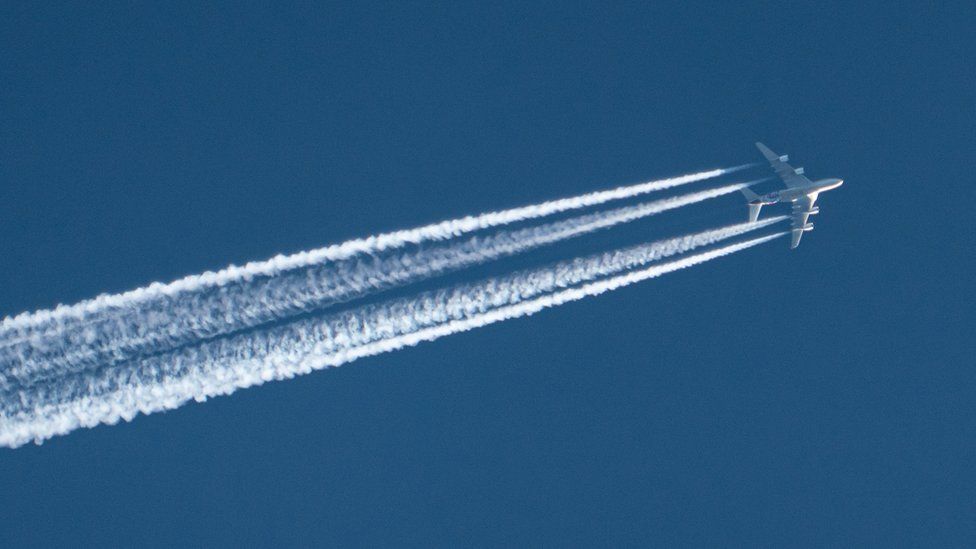“Chemtrail Smoked Ribs: A Flavorsome Conspiracy on Your Plate!”

The chemtrail conspiracy theory posits that the white trails left behind by aircraft, often referred to as “chemtrails,” are not ordinary condensation trails (contrails) but rather deliberate releases of harmful chemicals or substances by the government or other entities for undisclosed purposes. This conspiracy theory has been circulating since the late 1990s and has gained traction in certain circles, despite being widely debunked by experts and scientific evidence.
Here is an overview of the key claims and debunking of the chemtrail conspiracy:
- Contrails vs. Chemtrails: Contrails, short for condensation trails, are formed when hot engine exhaust mixes with the cold air in the upper atmosphere, causing water vapor to condense into tiny ice crystals. These contrails appear as white lines trailing behind the aircraft. According to the chemtrail conspiracy theory, these trails are intentionally different from contrails and are referred to as “chemtrails” to signify the presence of harmful chemicals.
- Purpose of Chemtrails: The alleged purposes of chemtrails vary depending on who you ask, as the conspiracy theory lacks a consistent narrative. Some claim that chemtrails are part of a large-scale geoengineering project conducted by governments to manipulate the weather, control the climate, or modify global warming. Others suggest that chemtrails are used for mind control, population reduction, or even as a way to spread diseases to control or harm the general population.
- Chemical Content: Believers in the chemtrail conspiracy often claim that these trails contain a variety of harmful substances, including but not limited to aluminum, barium, strontium, and other toxic chemicals. They argue that these chemicals can have adverse health effects on people exposed to them over time.
- Persistence and Spreading of Trails: One of the key arguments made by chemtrail proponents is that contrails from aircraft shouldn’t persist for long periods and spread out to cover large areas. They claim that these long-lasting and spreading trails are evidence of chemtrail activity. However, atmospheric scientists and experts have thoroughly explained that these phenomena are natural consequences of certain atmospheric conditions, such as humidity and wind patterns.
Ingredients:
- 2 racks of pork baby back ribs (about 4-5 pounds total)
- 1/4 cup brown sugar
- 2 tablespoons paprika
- 2 tablespoons garlic powder
- 2 tablespoons onion powder
- 1 tablespoon chili powder
- 1 tablespoon cumin
- 1 tablespoon black pepper
- 1 tablespoon salt
- 1 teaspoon cayenne pepper (adjust to your desired level of spiciness)
- 1/2 cup barbecue sauce (your favorite brand or homemade)
Instructions:
- Prepare the ribs: Remove the membrane from the back of the ribs. To do this, use a knife to lift one corner of the membrane on the backside of the ribs, then grip it with a paper towel and pull it off in one piece. Trimming off excess fat is optional but can be done for a leaner result.
- Make the dry rub: In a bowl, combine the brown sugar, paprika, garlic powder, onion powder, chili powder, cumin, black pepper, salt, and cayenne pepper. Mix everything together until well combined.
- Apply the dry rub: Generously coat both sides of the ribs with the dry rub mixture, massaging it into the meat to ensure even seasoning. Let the ribs sit with the dry rub on for at least 30 minutes to allow the flavors to infuse into the meat. For an even more intense flavor, you can refrigerate the seasoned ribs overnight.
- Prepare the smoker: Preheat your smoker to around 225°F (107°C). You can use wood chips, such as hickory, applewood, or cherry wood, for smoking. Soak the wood chips in water for about 30 minutes before using them in the smoker.
- Smoke the ribs: Once the smoker is ready, place the seasoned ribs on the cooking grate. Close the lid and let the ribs smoke for approximately 4 to 5 hours or until the meat is tender and easily pulls away from the bones. During the smoking process, you can add soaked wood chips to keep the smoke going and enhance the flavor.
- Glaze the ribs: About 30 minutes before the ribs are done, brush the barbecue sauce over the top side of the ribs. Let it caramelize and create a sticky glaze. You can repeat this step once or twice, depending on your preference for sauciness.
- Rest and serve: Once the ribs are done, remove them from the smoker and let them rest for a few minutes before slicing them into individual ribs. Serve with your favorite sides, such as coleslaw, baked beans, or cornbread.
Enjoy your delicious aerodynamic smoked ribs, full of flavor and fall-off-the-bone tenderness!
